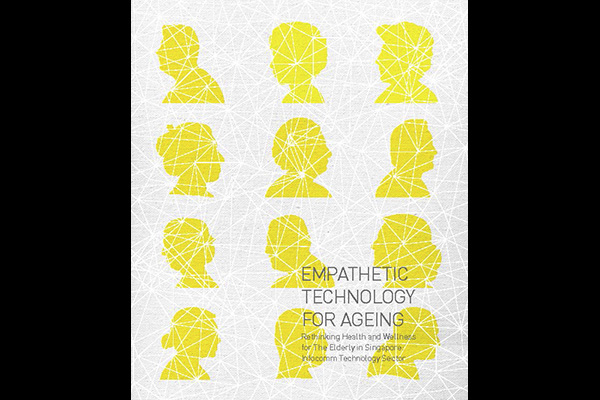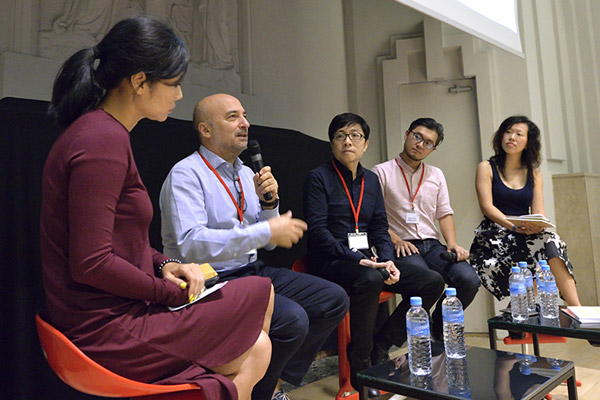In light of two recently launched research-driven publications: Design for Ageing Gracefully and Empathetic Technology for Ageing, Stephanie Peh speaks to the respective authors on effective housing and public infrastructures for the elderly.

October 8th, 2015
Top image: Community sharing. Photo courtesy of DesignSingapore Council
By 2030, over 900,000 Singaporeans would have headed into their silver years – that is three times the number of Singaporeans aged 65 today. While policies are being implemented for sustainable population, an area that needs addressing is quality of life, as new seniors would have led different lives and have varying demands, as compared to seniors now. Needless to say, design schemes, from housing to public infrastructures and health care services need to be progressive and empathetic.
Two publications, Design for Ageing Gracefully and Empathetic Technology for Ageing, recently launched by the DesignSingapore Council (DSG), offers a spectrum of findings that will aid multiple disciplines, created for anyone looking to gain in-depth understanding on the ageing situation and the mindsets of varying senior citizen personality types.
To write the books, two elderly groups of differing backgrounds, health and characteristics, were interviewed and shadowed. Design for Ageing Gracefully, put together by international experience design consultancy Experientia, looks into design experiences for seniors within spaces and highlights the gaps, trends and guidelines for effective design. Empathetic Technology for Ageing on the other hand, by innovation and strategy consultancy firm Orcadesign Consultants and SupraCopula, offers a compilation of 12 elderly personas, assisting the reader in understanding the motivations and perspectives of various elderly types.

Emphatic Technology For Ageing
We speak to Jeremy Sun of Orcadesign Consultants and Michele Visciola of Experientia. Both founders talk about effective design features for elderly in housing, public facilities, as well as what we need to see more of in years to come.
Stephanie Peh (SP): The concept of ‘Ageing In Place’ was introduced in Empathetic Technology for Ageing. What are some of the effective interior design features in home-based healthcare to date?
Jeremy Sun (JS): Currently, many interior design solutions focus on the modification of existing home settings. For example, adding rails to bathrooms and bedside areas. These are generally effective, but they are retrofitted. Instead, elderly-friendly solutions should be considered and conceptualised at the early phases of design and construction.
During our research, we observed a handful of elderly and caregivers creating their own solutions to better manage their lives. For example, one of our elderly respondents, Granny Tan is 92 years old and enjoys cooking. For her safety and comfort, her family bought a tall stool for her to sit comfortably while cooking.
There is a need for more elderly-friendly features [in housing]. Many families are just trying to make do with existing home features now.

Dialogue Session between DesignSingapore Council, Experientia, Orcadesign and SupraCopula at the launch of the publications
SP: What are some of the noteworthy elderly infrastructure and public facilities featured worldwide now?
Michele Visciola, (MV): The best examples of infrastructure for the elderly are those that don’t try to cordon the elderly off into isolated structures, but which focus on integrating the daily lives of elderly people into the broader community, by improving the general infrastructure so it’s elderly appropriate and accessible.
In the Netherlands, KWIEK is an urban exercise route that cleverly uses street furniture as opportunities to activate elderly people, with age-appropriate exercises. A lamp post turns into a spot to stretch shoulders, a bench becomes a place to exercise your legs and bollards on the street become a slalom. Specially designed street tiles mark where and what kind of exercise you could perform, and direct you to the next exercise to complete the route. The space can be used by anyone, but physiotherapist Mariska Haazen, who was also closely involved in the development of the project, regularly accompanies small groups of elderly along the route. The social component of exercising together is an important aspect of the idea.
The idea is a more social take on the idea of ‘playgrounds for the elderly’. These have existed for quite some time in China and Japan. They began to penetrate Europe in about 2008 and are quite pervasive in Singapore. These spaces, equipped with open-air free exercise stations, are ways to encourage the elderly to be active, but they should also bring the elderly into everyday view, and remind people that growing older is a natural and positive part of life.

Shadowing exercise. Photo courtesy of DesignSingapore Council
SP: Based on your research, what do we need to see more of in 2020, in terms of architecture and how elderly homes are designed?
MV: It’s important that architects think about how to integrate the elderly into the broader community and how to spread social intelligence throughout the close community.
Denmark’s Sølund Retirement Community envisions an inclusive mixed-use development for retirees, where elderly care and housing is situated in the community, to create a sense of diversity. It includes a children’s daycare centre, as well as facilities for rehabilitation and therapy, grocery shopping, dining, group and club activities and open spaces for the local elderly community. Its philosophy is that architectural framework can help us to combat the stigma of ageing and encourage interaction between the elderly and the broader community.
Our homes needs to be rethought as places we want to live and age in. ‘Ageing in place’, that is, living at home well into old age, is something that many people prefer, but often our home environments don’t support it. In addition to the obvious accessibility and mobility issues, we need infrastructure that prevents isolation, which helps people to do home maintenance tasks that they can’t perform themselves.
Another emerging trend is smart homes that support people as they grow more forgetful or less physically able. Alerts can let us know if a door is opened, the stove left on, and other home hazards. These kinds of systems may also be able to alert our loved ones, who can come to check on us if there’s a signalled problem.
JS: We foresee public spaces and homes of 2020 playing key roles in the promotion of active ageing. Beyond providing physical safety to the elderly, architecture and homes also need to meet [their] psychological and emotional needs.
We anticipate solutions that not only bring convenience to healthcare access, but also encourage social interaction between the elderly and their communities. Eventually, these solutions will contribute to a higher level of well-being amongst the elderly and their caregivers.
To find out more, Design for Ageing Gracefully and Empathetic Technology for Ageing is available online: http://www.designsingapore.org/for_enterprises/Design_Research.aspx
A searchable and comprehensive guide for specifying leading products and their suppliers
Keep up to date with the latest and greatest from our industry BFF's!

Sub-Zero and Wolf’s prestigious Kitchen Design Contest (KDC) has celebrated the very best in kitchen innovation and aesthetics for three decades now. Recognising premier kitchen design professionals from around the globe, the KDC facilitates innovation, style and functionality that pushes boundaries.

Channelling the enchanting ambience of the Caffè Greco in Rome, Budapest’s historic Gerbeaud, and Grossi Florentino in Melbourne, Ross Didier’s new collection evokes the designer’s affinity for café experience, while delivering refined seating for contemporary hospitality interiors.

In the pursuit of an uplifting synergy between the inner world and the surrounding environment, internationally acclaimed Interior Architect and Designer Lorena Gaxiola transform the vibration of the auspicious number ‘8’ into mesmerising artistry alongside the Feltex design team, brought to you by GH Commercial.

Savage Design’s approach to understanding the relationship between design concepts and user experience, particularly with metalwork, transcends traditional boundaries, blending timeless craftsmanship with digital innovation to create enduring elegance in objects, furnishings, and door furniture.
The internet never sleeps! Here's the stuff you might have missed

Milanese artisan Henry Timi celebrates natural materials through strikingly reduced geometric forms, creating a stripped-back vision of interior luxury.

Leading the charge for sustainable design, X+O and Nudie Jeans are both making a statement in Brisbane and doing it with creativity and innovation.